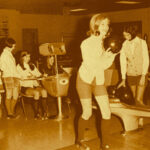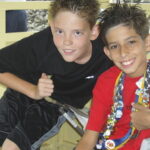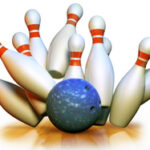For the bowler that gets a little more serious about his game, few things will get under the skin like persistent corner-pin leaves. For the left-handed bowler, ‘corner pin’ refers to the 7-pin; for right-handers it is the 10-pin. There are any number of reasons why an otherwise flush hit might result in recurring corner pins, so knowing why the pin remains is equally as important as knowing what adjustment must be made in order to better ensure that the corners will fall when the shot is good.
Observation is the key to understanding why you left a corner pin. If you are a bowler that just throws the ball and watches it hit the pins, you might be missing out on several important clues as to why you are persistently failing to carry the corners. The first and most important tip is to be observant of all facets of your approach from pushaway to release. Further, observe whether the ball hit the intended target on the lane, whether it crossed the breakpoint at the appropriate spot, and finally how the ball enters the pocket.
Corner pins can be the result of very slight errors that may occur during the approach, or they might result from a change in ball reaction on the lane. This article will not cover the varying aspects of the approach. Your approach is far too individualized for me to make suggestions here. The best way of hammering out the problem areas between pushaway and release is to find a competent coach that can work with your style of bowling and make adjustments with you. Once you’ve managed the basic control of your body during the approach, however, we’re left with the effects of the release and ball reaction down lane in diagnosing corner pin leaves.
The Release
Corner pins can be the result of a poor release. One of the most common problems with release that may result in a corner pin leave is letting the elbow fly away from the body – we call it ‘chicken-winging’ the ball (see figure 1). The result of chicken-winging is that the ball will have a tendency to spin more like a top and less gyroscopically than would be optimal. When the ball is spinning, it loses its ability to grab the dry part of the lane and doesn’t finish well in the pocket.
Another common problem with release is when the bowler fails to keep a firm wrist – we call this ‘breaking the wrist’ (see figure 2). When the wrist breaks backwards, the bowler loses leverage on the shot and the ball has fewer revolutions. The end result is similar to a shot that is ‘chicken winged’ – the ball cannot grab the lane effectively when it reaches the dry boards downlane and hits the pocket weakly.
Diagnosing a release problem is often a matter of watching the 4-pin (lefties) or 6-pin (righties). The 4 or 6 will usually fall weakly into the gutter without ever having the impetus to kick out the corner pin. If you see such a reaction by the 4 or 6, it becomes important to pay particular attention to those aspects of your approach in order to consciously keep the elbow at the side of the body and the wrist firmly locked in position. Some bowlers wear wrist devices specifically intended to prevent the wrist from changing positions during the arm swing and release. If you feel it is necessary to wear such a device, see your local pro-shop for the various options available to you.
Fixing a chicken-wing issue is something best managed by a competent coach and practice. However, if you do not have a coach at the moment, you might start by simply practicing your swing without a ball in your hand. This can obviously be done anywhere (and doesn’t cost you money). Mimic your normal arm-swing (the approach is not necessary), during which you should feel your arm lightly brushing against your side. Generally the part of your arm that makes contact with your side will be the inside of the elbow. If you do not feel your arm brush against your side, it’s likely that you’re chicken-winging your shot. When you get a chance to get to the bowling center, pay special attention to your arm when making shots.
Managing these release issues is only the first step to ensuring that you’ll have an easier time carrying the corners. Fixing problems with your release will make you a better all around bowler, but it will not be the cure-all for corner pin leaves.
Lane Issues
Sometimes a bowler will do everything right on a physical level and still leave the corners on otherwise flush hits. If you know that the corner-pin leave did not come from a poor release, then looking at the ball reaction on the lane might provide clues as to why the corner failed to go down. As competition goes on, oil is pushed beyond the original end of the lane pattern. When this happens, the breakpoint we might have relied on in the first game becomes slick and unpredictable. Many times I have observed the arc of my ball downlane and seen it skid slightly at the breakpoint. With that extra few inches of skid, the ball enters the pins slightly behind the headpin and leaves a corner pin.
Watching the corner, a skid-out 7- or 10-pin will look a lot like one left as a result of a poor release. The 4 or 6 will just flop into the gutter. Fixing a skid-out problem is just a matter of finding a new breakpoint. If the bowler is consistent in targeting the breakpoint, altering the breakpoint will be a matter of moving only a couple boards inside or outside of the original breakpoint. For example, if the original breakpoint is around the 10-board at 45 feet downlane, the adjustment might take us to the 8-board at the same distance with a slightly straighter shot.
Flying and wrapped corners are an entirely different matter. A flying corner is best identified as occurring when the 4- or 6-pin flies around the corner pin without ever making contact. A wrapped corner is similar to the flying corner in that the 4- or 6-pin wraps around the barrel of the corner pin without touching it. The shots are otherwise perfect except for the corner pin leave. Bo Burton, the color commentator for ABC’s coverage of PBA bowling, used to describe such hits by saying simply that when one round object hits another round object the result is not always the same. In other words, while a perfect shot carried the corner in one shot, another shot of equal precision might not kick out the corner pin.
So what do we do under such circumstances? Again, simple observation can help to prevent these leaves. Slow corners, 7- or 10-pins that fall late (without messengers), often alert the observant bowler to potential solid corners that may occur on future shots. Making small adjustments to bring the ball just a fraction higher in the pocket is the best course of action to ward off frustrating corners. Here are a few such adjustments:
- Slide backwards a couple inches on the approach. This adjustment gives the ball slightly more time on the lane and allows it turn earlier. The end result is a high-flush hit that has better potential to kick out the corner.
- Make ½ board adjustment outside of your original starting point on the approach. Many bowlers don’t believe such a small adjustment has any value, but I’ve discovered that even the slightest change on the approach can make a difference at the breakpoint. The result of this adjustment is the same as the previous tip – a flatter line to the pocket will bring the ball into the pocket slightly higher.
- Make a 2:1 adjustment (2 boards with the feet and one board with the target to the left or right) in either direction. Making this adjustment to the outside will flatten out your shot and bring the ball higher into the pocket. Making this adjustment to the inside will push the ball into the dry part of the lane a little earlier, causing the ball to turn earlier. The result is the same as above: a higher flush hit in the pocket.
It is important that you make only ONE adjustment out of the three above. That might be glaringly apparent when looking at the list of adjustments you can make, but if one adjustment doesn’t work you should know to return to your original starting position before trying another adjustment.
Wrapping It Up
Corner pins don’t have to be confusing or frustrating. With a little knowledge of why the corners remain after otherwise good hits, you can make adjustments as they are needed in order to keep the strikes falling. Further, the astute bowler will make the necessary adjustments before they are necessary by observing ball reaction and pinfall. There’s virtually no mystery to why corner pins fail to fall once a little knowledge has been gathered. Avoiding them (well, more of them, anyway) is just a matter of applying that knowledge on the lanes.
Good bowling!






